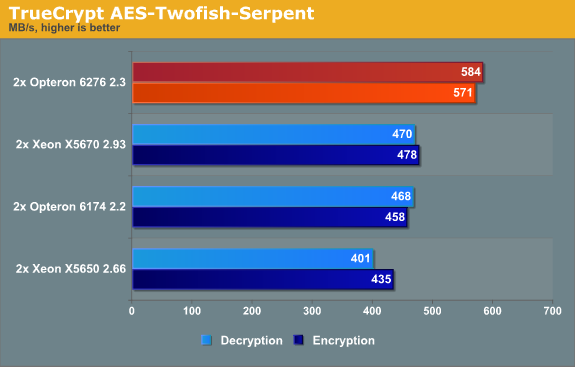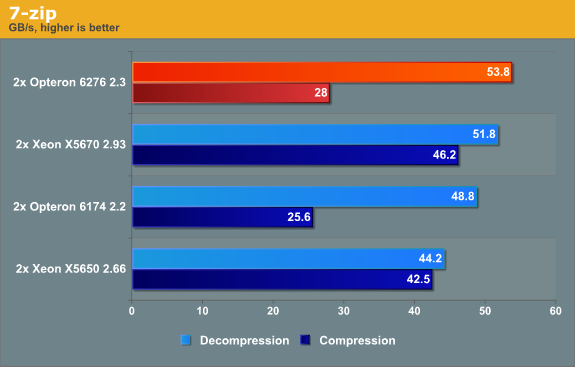Bulldozer for Servers: Testing AMD's "Interlagos" Opteron 6200 Series
by Johan De Gelas on November 15, 2011 5:09 PM ESTTrueCrypt 7.1 Benchmark
TrueCrypt is a software application used for on-the-fly encryption (OTFE). It is free, open source and offers full AES-NI support. The application also features a built-in encryption benchmark that we can use to measure CPU performance. First we test with the AES algorithm (256-bit key, symmetric).

You can compare those numbers directly with Anand's benchmark here. The Core i7-2600K at 3.4GHz delivers 3.4GB/s and the AMD FX-8150 at 3.6GHz about the same 3.3GB/s. We get about 2.3 times the performance here with four times as many "cores", but at 2.3GHz instead of 3.6GHz.
We also test with the heaviest combination of the cascaded algorithms available: Serpent-Twofish-AES.

The combination benchmark is limited by the slowest algorithms: twofish and serpent. The huge advantage that the architectures (Opteron "Bulldozer" and Xeon "Westmere") which support AES-NI had has evaporated: the Opteron 6174 keeps up with the best Xeons. The Opteron 6276 can leverage its higher threadcount as this benchmark scales extremely well.
It is good to realize that these benchmarks are not real-world but rather synthetic. It would be better to test a website that does some encrypting in the background or a fileserver with encrypted partitions. In that case the encryption software is only a small part of the total code being run. A large performance (dis)advantage might translate into a much smaller performance (dis)advantage in that real-world situation.
For example, eight times faster encryption resulted in a website with 23% higher throughput and a 40% faster encrypted file (see here). The advantage that the Xeon had in the first benchmark will not be noticeable, and the Opteron's 24% higher performance will translate into a few percentage points. But this is a benchmark where AMD's efforts to get a 16 integer cores inside a 115W TDP pay off.
7-Zip 9.2
7-zip is a file archiver with a high compression ratio. 7-Zip is open source software, and most of the source code is under the GNU LGPL license

Compression is more CPU intensive than decompression, and the latter depends a little more on memory bandwidth. When it comes to load/stores and memory bandwidth, the Opteron 6276 is unbeateable. We've also seen indications that Bulldozer's cache does very well in reads but not so well in writes, and that could account for some of the gap between the compress/decompress results.
Compression is for a part determined by the quality of the branch predictor (higher than normal branch mispredictions on mediocre branch predictors). The Opteron 6276 has a better branch predictor than the Opteron 6174, but the branch misprediction penalty has grown from 12 to 20 cycles. As a result, a single branch intensive thread runs slower (see Anand's tests) on the newest AMD architecture. Luckily, the AMD Opteron 6276 can compensate for this with its 16 threads (vs 12 threads for the Opteron 6172) and a little bit of help from Turbo Core.
Intel still has the best branch predictors in the industry. The result is that the Xeon is by far the fastest compressor. The end result is that the Xeon is the more rounded CPU in this discipline.










106 Comments
View All Comments
geoxx - Friday, December 9, 2011 - link
Sorry but neotiger is totally right, choice of benchmark sucks. We are not helped *at all* by your review.What company 32-core server is being used for 3D rendering, cinebench, file compression, truecrypt encryption??
You benchmarked it like it was a CPU of the nineties for a home enthusiast.
You are probably right pointing us to http://www.anandtech.com/show/2694 but your benchmarks don't reflect that AT ALL. Where are file compression, encryption, 3D rendering and cinebench in that chart?
Even performances per watt is not very meaningful because when one purchases a 2-socket or 4-socket server, electricity cost is not an issue. Companies want to simplify deployment with such a system, they want this computer to run as fast as a cluster, in order not to be bound to cluster databases which are a PAIN. So people want to see scalability of applications to full core count on this kind of system, not so much performances per watt.
Virtualization is the ONLY senseful benchmark you included.
TPC as suggested is a totally right benchmark, that's the backend and bottleneck for most of the things you see in your charts at http://www.anandtech.com/show/2694 , and objection on storage is nonsense, just fit a database in ramdisk (don't tell me you need a database larger than 64GB for a benchmark), export as block device, then run the test. And/or use one PCI-e based SSD which you certainly have.
http://www.anandtech.com/show/2694 mentions software development: how much effort does it require to set up a linux kernel compile benchmark?
http://www.anandtech.com/show/2694 mentions HPC: can you set up a couple of bioinformatics benchmarks such as BLAST (integer computation, memory compare), GROMACS (matrix FPU computations) and Fluent? Please note that none of your tests includes memory compares and FPU which are VERY IMPORTANT in HPC. Gromacs and fluent would cover the hole. Bioinformatics is THE hpc of nowdays and there are very few websites, if any, which help with the choice of CPUs for HPC computing.
For email servers (37%!) and web servers (14%) also I am sure you can find some benchmarks.
Iketh - Tuesday, November 15, 2011 - link
I'm not sure how the discovery of cores running in their power-saving state for far too long is anything new. My 2600k refuses to ramp up clocks while previewing video in a video editor even though a core is pegged at 100%. If I intervene and force it to 3.4ghz, preview framerate jumps from 8 fps to 16fps.This has been happening for YEARS! My old quad Phenom 2.2ghz did the exact same thing!
It's extremely annoying and pisses me off I can't benefit from the power savings, let alone turbo.
MrSpadge - Tuesday, November 15, 2011 - link
Sounds like you're running linux or some other strange OS, then. Or you may need a bios update. Generally Intel has its power management quit under control. In the AMD camp physical power state switches often take longer than the impatient OS expects, and thus average frequency is hurt. This was pretty bad for Phenom 1.MrS
Iketh - Tuesday, November 15, 2011 - link
win7 home premium x64 and the phenom was with xp 32bit... i haven't found another scenario that causes this, only streaming video that's rendered on-the-flyZoomer - Wednesday, November 16, 2011 - link
You have a 2600k and aren't running it at 4+ GHz?Iketh - Wednesday, November 16, 2011 - link
4.16 @ 1.32v when encoding, 3.02 @ 1.03v for gaming/internethaplo602 - Wednesday, November 16, 2011 - link
you do know that Linux did not have any problems with Phenom I power management unlike Windows ? Same is not with BD. Linux benchmarks look quite different from Windows and the gap is not that dramatic there.BrianTho2010 - Tuesday, November 15, 2011 - link
This whole review, the only thought I have is that there are no sandy bridge chips in it. When SB based Xeon chips come out I bet that Interlagos will be completely dominated.Beenthere - Tuesday, November 15, 2011 - link
Not really. SB chips don't fit in AMD sockets. AMD's installed customer base like the significant performance increase and power savings by just plugging in a new Opteron 6200/4200.C300fans - Tuesday, November 15, 2011 - link
It will. 2x6174 (24 cores) perform quite similar to 2x6274(32 cores). WTF